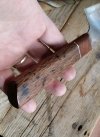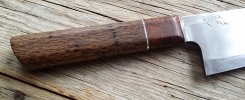I ordered a piece of Spalted myrtle wood from Cook Woods a few years ago and when I cut into it after letting it dry there are worm tracks. They are filled with looks like packed sawdust (I'm assuming it's waste from the larva as they burrow through). To send it off to be stabilized should I pick it all out first? I'm thinking about just filling them with colored resin and using them like that. Will the stabilization process harden all that where I won't be able to get it out?
-
The BladeForums.com 2024 Traditional Knife is ready to order! See this thread for details: https://www.bladeforums.com/threads/bladeforums-2024-traditional-knife.2003187/
Price is$300$250 ea (shipped within CONUS). If you live outside the US, I will contact you after your order for extra shipping charges.
Order here: https://www.bladeforums.com/help/2024-traditional/ - Order as many as you like, we have plenty.
You are using an out of date browser. It may not display this or other websites correctly.
You should upgrade or use an alternative browser.
You should upgrade or use an alternative browser.
Worm Tracts
- Thread starter Jrmysell
- Start date
weo
Basic Member
- Joined
- Sep 21, 2014
- Messages
- 3,069
I'd call and ask whoever is going to stabilize them. The holes and dust might (probably will) get saturated with resin, but I'm not sure how it will look.To send it off to be stabilized should I pick it all out first? I'm thinking about just filling them with colored resin and using them like that. Will the stabilization process harden all that where I won't be able to get it out?
I also think it will be quite difficult to pick out the dust. The holes most likely wander around through the block.
Stacy E. Apelt - Bladesmith
ilmarinen - MODERATOR
Moderator
Knifemaker / Craftsman / Service Provider
- Joined
- Aug 20, 2004
- Messages
- 38,109
Most likely termites.
Leave it in the tracks. It stabilizes well and makes a very neat looking effect as you grind and shape it. I have a bunch of spalted persimmon that the termites got into and it is one of my favorite handle materials.
Leave it in the tracks. It stabilizes well and makes a very neat looking effect as you grind and shape it. I have a bunch of spalted persimmon that the termites got into and it is one of my favorite handle materials.
weo
Basic Member
- Joined
- Sep 21, 2014
- Messages
- 3,069
I'd really like to see a pic. I can't imagine it looking good. But perhaps my bias is from having to replace all the wood on my old house from about knee height down to the ground (sill plates, joists, posts, flooring, and studs) due to powder post beetle damage years ago.and makes a very neat looking effect as you grind and shape it.
Jesse Latham
Gold Member
- Joined
- Jul 4, 2010
- Messages
- 848

Here is a handle of maple with worm tracks.
- Joined
- Jan 10, 2015
- Messages
- 1,673


